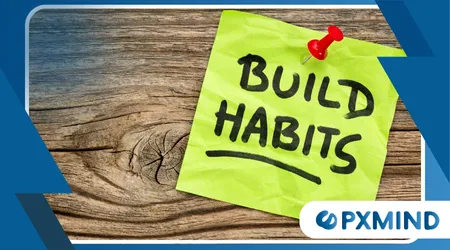How the Brain Builds (and Breaks) Habits

The fascinating question of How the Brain Builds (and Breaks) Habits lies at the core of human behavior.
Anúncios
Our daily lives are a complex tapestry woven from countless automated actions, from brushing our teeth to navigating our morning commute.
These habits, both good and bad, are not just random occurrences. They are the result of an intricate neurochemical dance.
The brain, in its constant quest for efficiency, seeks to automate repetitive tasks. It does this to free up cognitive resources for more complex thinking.
This efficiency is governed by the basal ganglia, a region deep within the brain. It plays a pivotal role in motor control and learning.
The basal ganglia is like the brain’s internal shortcut creator. When we repeat an action, this part of the brain consolidates the sequence.
It links a cue to a routine and, finally, to a reward. This process forms what neuroscientists call the “habit loop.”
The Habit Loop: Cue, Routine, and Reward
Consider the quintessential habit loop. It begins with a cue or a trigger. This could be a specific time of day, a location, or even an emotional state.
The brain recognizes this cue and signals that a particular routine should begin. The routine is the action itself, the behavior we perform.
The final and critical component is the reward. This reward, which can be a feeling of pleasure, a sense of accomplishment, or a reduction of stress, tells the brain that the routine was valuable.
It reinforces the connection, strengthening the neural pathway. This neuroplasticity is the brain’s ability to reorganize itself by forming new neural connections.
For example, imagine you are a freelancer working from home. The cue might be the post-lunch slump. The routine is to get a cup of coffee.
The reward is the jolt of caffeine and a renewed sense of focus. The brain, seeking that reward, automates the sequence.
It makes the behavior more likely to occur the next time the cue appears.
The Power of Repetition and the Brain’s Architects
The more an action is repeated, the more robust the neural pathway becomes. This is akin to carving a path in the wilderness.
The first time you walk it, the path is barely visible. With each subsequent journey, the path becomes wider and more defined.
Read here: The Neuroscience of Focus and Attention
This is precisely How the Brain Builds (and Breaks) Habits. It’s not just about willpower; it’s about a physical change in our neural architecture.
The brain essentially rewires itself to make the habit automatic. It moves the processing of the action from the conscious, prefrontal cortex to the more automatic basal ganglia.
This shift explains why breaking bad habits is so difficult. The habit loop is ingrained, a well-worn path. It’s no longer a conscious choice but a knee-jerk reaction.
A powerful example is the smartphone addiction. The cue is a notification sound. The routine is to pick up and unlock the phone.
The reward is a hit of dopamine from seeing a new post or message. This loop can become so deeply entrenched that it bypasses conscious thought.

Unraveling the Neural Pathways: How to Break a Habit
Breaking a habit is not about simply eliminating the behavior. It’s about creating a new loop that can overpower the old one.
The key is to consciously identify the cue and the reward and then to substitute a new routine.
A 2018 study published in the journal Neuron highlighted the role of the prefrontal cortex in inhibiting old habits and establishing new ones.
Check this out: The Brain on Stress: What Really Happens Inside Your Head
The study suggests that conscious effort is required to override the automatic responses of the basal ganglia.
In essence, it’s about making the decision to take a different path, even when the old one is so tempting.
Consider this strategic shift. The cue is coming home from work. The old routine is to grab a snack and turn on the television.
The reward is relaxation and comfort. To break this, one must keep the cue and the reward but change the routine.
Instead of the TV, the new routine could be a 15-minute walk. The brain still receives its reward of stress reduction, but through a new and healthier behavior.
This process highlights the incredible adaptability of the brain. It can be consciously reprogrammed.
The Role of Dopamine and the Reward System
Dopamine, often called the “feel-good” neurotransmitter, is central to this process. It’s not just about pleasure, though.
Its primary function is to drive motivation and learning. When we receive a reward, a dopamine signal is released.
This signal acts as a marker. It tells the brain, “That action was good; remember to do it again.”
This neurochemical reinforcement is the glue that holds the habit loop together.
Read more: Digital Detox: Why Your Brain Needs It
The power of this system is evident in the fact that approximately 40% of our daily actions are habits, according to a 2006 Duke University study.
This staggering statistic underscores the importance of understanding How the Brain Builds (and Breaks) Habits. It is a testament to the brain’s incredible capacity for automation.
| Component | Description | Brain Region |
| Cue | A trigger for a behavior | Prefrontal Cortex, Sensory Areas |
| Routine | The action or habit itself | Basal Ganglia, Motor Cortex |
| Reward | A positive outcome that reinforces the behavior | Nucleus Accumbens, VTA (Ventral Tegmental Area) |
| Reinforcement | Strengthening of the neural pathway | Dopamine Pathways |
Conscious Effort and Patience
The journey of habit change is a marathon, not a sprint. It requires patience and a conscious effort to override ingrained behaviors.
It is a process of deliberate practice and the formation of new neural connections. Breaking a habit is analogous to redirecting a powerful river.
You can’t just wish the water away. You have to build a new channel, stone by stone, until the flow is diverted.
It’s a testament to the fact that while our habits feel automatic, we are not powerless.
Is it a herculean task? Perhaps. But understanding How the Brain Builds (and Breaks) Habits gives us the map we need.
It’s about being a neuro-architect of your own life, carefully laying down new pathways and consciously dismantling old ones.
The brain is an incredibly plastic and responsive organ. It responds to consistent, deliberate action.
With the right strategy and a deep understanding of its mechanisms, we can take control of our behavior and, ultimately, our lives.

Frequently Asked Questions
What is the “habit loop”?
It’s a three-part model that explains how habits are formed: a cue (trigger), a routine, and a reward. The brain learns to associate the cue with the routine to get the reward.
Why is it so hard to break a bad habit?
Bad habits are deeply ingrained in our brains. The neural circuits become so strong that the behavior becomes automatic, bypassing conscious control.
How can I replace a bad habit with a good one?
The most effective strategy is to keep the same cue and reward, but replace the routine.
For example, if the bad routine is watching TV after work, the new routine could be going for a walk to get the same feeling of relaxation.
How long does it take to build a new habit?
The time varies from person to person, but research suggests that consistency is more important than speed.
Focusing on small, consistent changes is key to forming new neural pathways.
